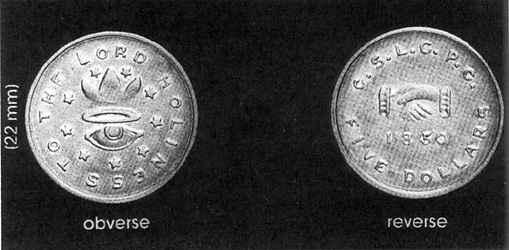
Economic History of the Church |

The first Utah gold coins were minted in September 1849. Designed by Brigham Young, John Taylor, and John Kay, the obverse reads, "Holiness to the Lord," with crown emblem of the priesthood over an All-Seeing Eye of Jehovah. On the reverse is "G. S. L. C. P. G." (Great Salt Lake City Pure Gold) and two clasped hands. Reprinted by permission from Alvin Rust, Mormon and Utah Coin and Currency (Salt Lake City, 1984).
by Leonard J. Arrington
From their beginnings Latter-day Saints have regarded economic welfare as an indispensable part of religion. An 1830 revelation received by Joseph Smith stated, "Verily I say unto you, that all things unto me are spiritual, and not at any time have I given unto you a law which was temporal" (D&C 29:34-35). Accepted as part of the revealed word of God, this principle implied that every aspect of life had to do with spirituality and things eternal. For President Brigham Young, who led the Church in the West for thirty years, this revelation meant that:
in the mind of God there is no such a thing as dividing spiritual from temporal, or temporal from spiritual; for they are one in the Lord (JD 11:18).
We cannot talk about spiritual things without connecting with them temporal things, neither can we talk about temporal things without connecting spiritual things with them…. We, as Latter-day Saints, really expect, look for and we will not be satisfied with anything short of being governed and controled by the word of the Lord in all of our acts, both spiritual and temporal. If we do not live for this, we do not live to be one with Christ [JD 10:329].
Emphasis on economics was strengthened and supported by the social and economic experiences of the early Saints. Two early decisions were extremely important. The first was to move the headquarters and body of the Church from New York to Kirtland, Ohio, and to Missouri. This meant that leaders had to devise ways of helping poor members move westward. The move also involved Church leaders in buying land and formulating plans for community development (see City Planning), and in initiating financial enterprises and industries to provide employment. As the germ of the kingdom of God, the Church was to gather and organize its members, settle them, and assist them in creating an advanced society. Ultimately, according to LDS belief, the Church must establish Zion, the literal and earthly kingdom of God over which Christ will one day rule in person.
The second decision came as a reaction to persecution. Church leaders assumed responsibility for coping with persecution and looking after the welfare of its persecuted members. Persecutions thus created cohesiveness and community identity. They also necessitated frequent removals, forcing the Church to organize for the migrations and, in a new home, again purchase land and initiate industries. Above all, persecution prevented the rise of individualism and class distinction and diminished the surplus wealth that would have created a barrier between the rich and the less fortunate.
These experiences, and the social, intellectual, and religious origins of the Church, led to the development of a set of economic ideals and institutions that became a more or less permanent aspect of Latter-day Saint belief and practice, and made the LDS community a unique group in frontier America. The intimate association of religion with economic activity produced a planning and community concern that made possible a more just and permanent society than existed elsewhere in the West. These early LDS economic goals can be summarized under four headings: (1) ecclesiastical promotion of economic growth and development, often called "building the Kingdom of God"; (2) ecclesiastical sponsorship of group economic independence and self-sufficiency; (3) cooperation and organized group activity for attaining these goals; and (4) achievement and maintenance of economic equality.
PROMOTION OF ECONOMIC GROWTH. An early revelation called for the gathering "of mine elect" and declared that "the decree hath gone forth from the Father that they shall be gathered in unto one place upon the face of this land" (D&C 29:7-8). Thus gathered, they could build the kingdom of God and prepare for the Millennium to come.
This policy of "accumulating people" as a prerequisite to building the kingdom was implemented, beginning in the 1830s, by the development of a large and effective missionary system and an overseas emigration service (see Immigration and Emigration), and by the establishment of a series of Zions or gathering places. This emigration system assisted 5,000 European converts in migrating to Nauvoo, illinois, and, beginning in 1846, organized 16,000 persons in and around Nauvoo to make the great trek to winter quarters, Nebraska, and later to the Salt Lake Valley. The perpetual emigrating fund company alone assisted in transporting some 26,000 immigrants to the West between 1852 and 1887, when Congress dissolved it (see Antipolygamy Legislation). By 1890 Church agents had directed the migration of 83,000 European members to the Salt Lake Valley. The system efficiently converted donations of cattle, grain, and other produce into passenger fares, covered wagons, and oxen. Scholars have regarded the Church's arrangements as perhaps the best system of regulated immigration in U.S. history.
Often immigrants newly arrived in Salt Lake City were first put to work building the kingdom by means of a public works system. Centered on Temple Square in Salt Lake City, the Church Department of Public Works provided employment for immigrants during their first winter in the Salt Lake Valley. They added such useful structures to the commonwealth as roads, walls, meetinghouses, railroads, telegraph lines, canals, the Salt Lake theatre, and the famous Salt Lake Temple and tabernacle.
New arrivals were soon dispatched in organized companies to settle in outlying agricultural villages (see Colonization). Rights and property in these villages were allocated and regulated to ensure the highest possible development of resources. The governing principle, one of stewardship, was consistent with the heavenly instruction of 1830 that declared: "Every man shall be made accountable unto me, a steward over his own property" (D&C 42:32). Each was to have property sufficient to support his family, while any surplus belonged to the Lord's storehouse. Property rights were granted conditionally and were not protected if the owner refused to utilize or develop the property. Indeed, the first pronouncement of President Brigham Young regarding government of the infant pioneer colony in the Salt Lake Valley included the following stipulation:
No man will be suffered to cut up his lot and sell a part to speculate out of his brethren. Each man must keep his lot whole, for the Lord has given it to us without price…. Every man should have his land measured off to him for city and farming purposes, what he could till. He might till as he pleased, but he should be industrious and take care of it [Arrington, 1958, p. 46].
This policy seems to have been adhered to. The speculative withholding of land from use was prohibited, and the purchase or appropriation of town lots simply for the sake of the increase in value was prevented. Hoarding money was also against Church rules.
After the settlement of villages and the determination of property rights, the Saints were to proceed with the orderly development of local resources. Making the waste places blossom as the rose and the earth yield abundantly was more than an economic necessity: It was a form of religious activity. One early leader noted that the LDS religion consisted of digging water ditches as well as undergoing water baptism; religious duty encompassed both the redemption of man's home (the earth) and of his soul. The earth, as the future abiding place of God's people, was to be made productive and fruitful, transformed into a virtual Garden of Eden. "The Lord has done his share of the work," Brigham Young told them. "He has surrounded us with the elements containing wheat, meat, flax, wool, silk, fruit, and everything with which to build up, beautify and glorify the Zion of the last days." "It is now our business," he concluded, "to mould these elements to our wants and necessities, according to the knowledge we now have and the wisdom we can obtain from the heavens through our faithfulness." Only in this way "will the Lord bring again Zion upon the earth, and in no other" (JD 9:283-84).
The acceptance of this stewardship principle of resource development explains the passionate and devoted efforts of Latter-day Saints to develop the resources of the Great Basin to their fullest extent.
ECONOMIC INDEPENDENCE. The goal of LDS colonization and resource development, and of the Mormon village, was economic independence: The LDS commonwealth was to be financially and economically self-sufficient. A revealed "law" of the Church established this principle in 1831: "Let all thy garments be plain, and their beauty the beauty of the work of thine own hands" (D&C 42:40). Another revelation directed that they were to "contract no debts with the world" (D&C 64:27).
The principles of this revelation were applied often and broadly. In the Great Basin, the Latter-day Saints were asked to manufacture their own iron, produce their own cotton, spin their own silk, and grind their own grain—all without borrowing from "outsiders." It was reasoned that self-sufficiency was a practical policy because God had blessed each region with the resources necessary for the use of the people and the development of that region. As a result of the application of this principle, the Great Basin was the only major region of the United States whose early development was largely accomplished without outside capital.
Officially sponsored projects for self-sufficiency included an iron mission, consisting of about 200 families called by the Church who devoted strenuous efforts to develop the iron and coal resources near Cedar City; a sugar mission, in which several hundred people were united in the 1850s in an effort to establish the sugar-beet industry in Utah; a lead mission, in which some fifty men were called to work lead mines near Las Vegas, Nevada, to provide lead for paint and bullets; a cotton mission, which sent more than a thousand families to southern Utah to raise cotton, olives, grapes, indigo, grain sorghum, and figs; silk missions, which involved the growing of mulberry trees and establishment of a silk industry in every suitable community; and a flax mission, a wool mission, and even a winery to provide wine for the holy Sacrament.
UNITY AND COOPERATION. Qualities required to execute successfully the economic program of the Church were unity of its members and the ability to organize for the pursuit of economic goals. This meant Churchwide cooperation. The seminal revelation enjoining unity was received in January 1831: "I say unto you, be one; and if ye are not one, ye are not mine" (D&C 38:27). This group spirit was induced both by the belief that unity was a Christian virtue and by the trying times that LDS pioneers experienced in their efforts to establish an independent commonwealth. Group solidarity and a strong central organization symbolized this effort. Whether they were migrating, building forts, digging ditches, or constructing mills, participants in the sublime task of building the kingdom were to submit themselves to the direction of God's leaders and display a spirit of willing cooperation.
As is well known, Brigham Young developed unified action and combined endeavor. He instituted cooperative arrangements for migration, colonization, construction, agriculture, mining, manufacturing, merchandising and, in fact, for every realm of economic activity.
EQUALITY. In "working out the temporal salvation of Zion," to use a common expression of the day, the formulators of Church policy focused primary attention on production and on the better management of available human and natural resources. Nevertheless, influenced by Christian principles, by its own necessities, and by the democratic concepts of Jacksonian America, early Mormonism was distinctly egalitarian in theology and economics. This had significant influences on Church policies and practices in the Great Basin.
The LDS doctrine of equality was formulated early. "If ye are not equal in earthly things, ye cannot be equal in obtaining heavenly things," read one March 1832 revelation (D&C 78:6), and, from the beginning, there was an earnest attempt to conduct business in this spirit of equality. When New York converts to the young Church began to arrive at the newly established gathering place of Kirtland, Ohio, in May 1831, the governing principle for the allotment of land and other properties was that every man receive "equal according to his family, according to their circumstances," and that all "receive alike, that ye may be one" (D&C 51:3, 9). Similarly, a revelation in Ohio instructed the Saints that "in your temporal things you shall be equal, and this not grudgingly, otherwise the abundance of the manifestations of the Spirit shall be withheld" (D&C 70:14). Similar instructions accompanied the stewardship system tried in Jackson County, Missouri: "And you are to be equal, or in other words, you are to have equal claims on the properties, for the benefit of managing…your stewardships, every man according to his wants and his needs, inasmuch as his wants are just" (D&C 82:17).
The core of the policy was reflected in the system of immigration (the more well-to-do were encouraged to donate means to assist in the immigration of poorer converts), the construction of public works (those with a surplus were expected to contribute), the allotment of land and water (parceled out equally to all by means of community drawings), and the initiation of many cooperative village stores and industries. But the influence of the ideal of equality was still wider. It led to several attempts to completely reorganize society and put economic affairs on a more egalitarian basis. Communities holding to these ideals were attempted by the Latter-day Saints in Ohio and Missouri (see Consecration) and in more than 150 communities in the Far West, from Paris, Idaho, on the north, to Bunkerville, Nevada, and Joseph City, Arizona, on the south (see United Orders). These cooperative communities were characterized by a high degree of economic equality and, although most of them lasted only a short time, their influence on LDS thought and self-conception is evident still.
It is fair to say that the Church could have gone much further in achieving its economic goals if the federal government had not intervened to prevent it. The Utah expedition of 1857-1858, the Anti-Bigamy Act of 1862, the antipolygamy legislation of the late 1860s and the 1870s, and, even more, the hostile Edmunds Act, passed in 1882, and the Edmunds-Tucker Act of 1887—all of these undercut new Church economic activity, and forced the Church to withdraw from many existing activities.
By a strange coincidence of history, however, the Panic of 1891, ushering in the more severe Panic of 1893 and depression of the 1890s, helped reverse this trend. Utah, whose agriculture and mining industries were marginal, suffered more severely than many states; unemployment and low farm incomes were disturbing realities. In this crisis, Church leaders used all the resources at their command—including assets confiscated earlier by the federal government but now returned—to expand and improve the Great Basin economy. Their concerted efforts helped launch many new and successful industries. With an investment of about $500,000, the manufacture of sugar was re-initiated; another $500,000 financed the beginnings of the hydroelectric power industry in the West; some $250,000 was expended on the development of a salt industry on the shores of Great Salt Lake. To provide employment, the Saltair recreation resort was constructed. Railroads were projected, canals built, new colonies started—in short, Church leaders did everything possible to expand the economic base of the Great Basin and surrounding regions.
This expansion of economic activity was disturbing to national political and business leaders, who used the Smoot hearings of 1903-1907 to force the Church to sell most of its business interests. Holdings in the sugar and salt industries, in railroad and hydroelectric power, in coal and iron lands, in the telegraph system—these and others were sold to eastern capitalists. For the next decade and more, Utah's economy came to resemble that of other states in the Rocky Mountain region.
By mid-twentieth century, national sentiment was more sympathetic to Church-sponsored endeavors. Since the Great Depression of the 1930s, and especially since World War II, through the Welfare Services plan and other enterprises, the economic ideals of the founding generation have again been more actively pursued. Nonetheless, growing needs, especially outside North America, have required refocusing on areas central to the mission of the Church. As in the past, tithing and other donations remain the key to the Church's active economic involvement. In the last half of the twentieth century, increasing emphasis has been placed on extending the full program of the Church, including temples, to members throughout the world. As "building the kingdom" has become increasingly international, the construction and maintenance of meetinghouses and temples in many lands have dominated Church finances. While the Church has invested in media facilities, including a satellite communications system, and expanded international microfilming of genealogical records (and a network of family history libraries to make the records available throughout the world), it has divested itself of many holdings that primarily benefited only Latter-day Saints in America's Mountain West.
At the end of the 1980s, the Church began implementing new budgeting arrangements that move toward greater equality. Divorcing funding levels from levels of contributions, these arrangements guarantee the funding of facilities and activities at a modest level for all Church members while limiting the amount the more affluent local units may spend. Also, with a growing worldwide membership, efforts at economic independence have increasingly focused on individual (family) self-sufficiency, and on aiding members everywhere to improve their economic situation and prepare for emergencies. Nonetheless, efforts to expand the reach and impact of the Church's Welfare Services and disaster relief programs also continue.
Though the present-day Church plays a direct role in economic development less often than it did in the pioneer economy, the fundamental ideals of self-sufficiency, unity and cooperation, and equality still characterize LDS economic goals. Latter-day Saints look forward to a more prosperous and just world even as they continue their efforts to establish institutions capable of blessing the lives of men and women as one essential preparation for the second coming of Christ.
[See also Kirtland Economy; Nauvoo Economy; Pioneer Economy; Daily Living home page; Church History home page]
Illustrations
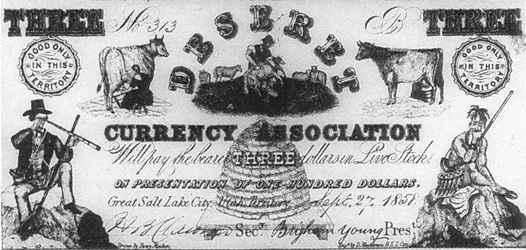
From 1857 to 1860, paper currency backed by livestock was printed over the signature of Brigham Young. These notes provided a medium of exchange for domestic growth and to finance the defense against the Utah Expedition. Brigham Young won a lawsuit in 1859 when the U.S. marshal confiscated the printing plates. Nearly all of these notes were redeemed by 1860. Reprinted by permission from Alvin Rust, Mormon and Utah Coin and Currency (Salt Lake City, 1984).
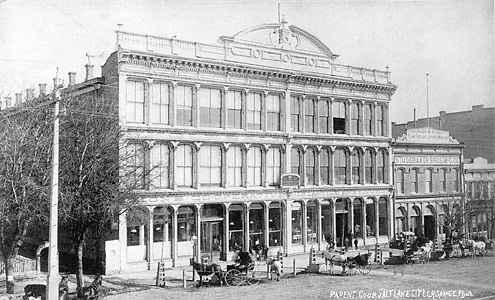
Zion's Cooperative Mercantile Institution (ZCMI) in Salt Lake City, c. 1880, was the parent outlet of what eventually became a territory-wide cooperative system. The cast-iron storefront has recently been restored. Photographer: Charles R. Savage.
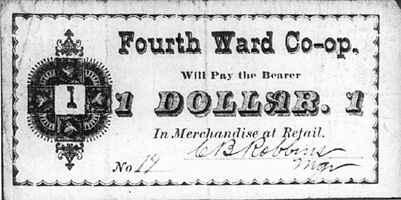
The first cooperative in Utah was founded by Lorenzo Snow in Brigham City in 1864. Using the Rochdale system of cooperation from England, the idea soon spread throughout Utah Territory. Scrip, such as this Logan Fourth Ward note, was issued by these co-ops to facilitate trade. Reprinted by permission from Alvin Rust, Mormon and Utah Coin and Currency (Salt Lake City, 1984).

Brigham Young's Cotton and Woolen Factory, located at the mouth of Parley's Canyon, east of Salt Lake City. This mill, one of several opened along the Wasatch front, began operation in 1863 and closed two years later in order to relocate the machinery in southern Utah. Photograph: A. J. Russell.
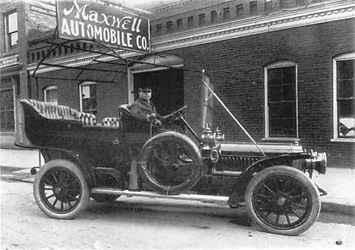
The Maxwell automobile was manufactured in Salt Lake City in the early twentieth century by independent entrepreneurs. Photographer: Charles Ellis Johnson. Courtesy Rare Books and Manuscripts, Brigham Young University.
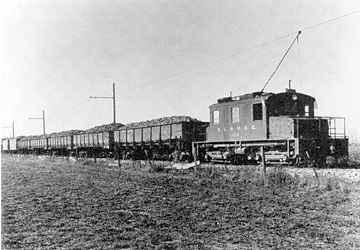
The Church owned and financed the development of an extensive sugar beet industry in Utah and Idaho. U and I Sugar Company resulted in 1907 from a merger, and various railroad companies, some wholly or partially owned by the Church or its leaders, served the intermountain area in the late nineteenth and early twentieth centuries. The Utah Railroad Company and the Salt Lake and Utah Railroad, shown here loaded with sugar beets, ran the Orem Line in the 1920s. Courtesy Rare Books and Manuscripts, Brigham Young University.
Bibliography
Arrington, Leonard J. Great Basin Kingdom: An Economic History of the Latter-day Saints, 1830-1900. Cambridge, Mass., 1958.
Arrington, Leonard J. "Religion and Economics in Mormon History." BYU Studies 3 (Spring-Summer 1961):15-33.
Arrington, Leonard J.; Feramorz Y. Fox; and Dean L. May. Building the City of God: Community and Cooperation Among the Mormons. Salt Lake City, 1976.
Encyclopedia of Mormonism, Vol. 1, Economic History of the Church
Copyright © 1992 by Macmillan Publishing Company
All About Mormons |